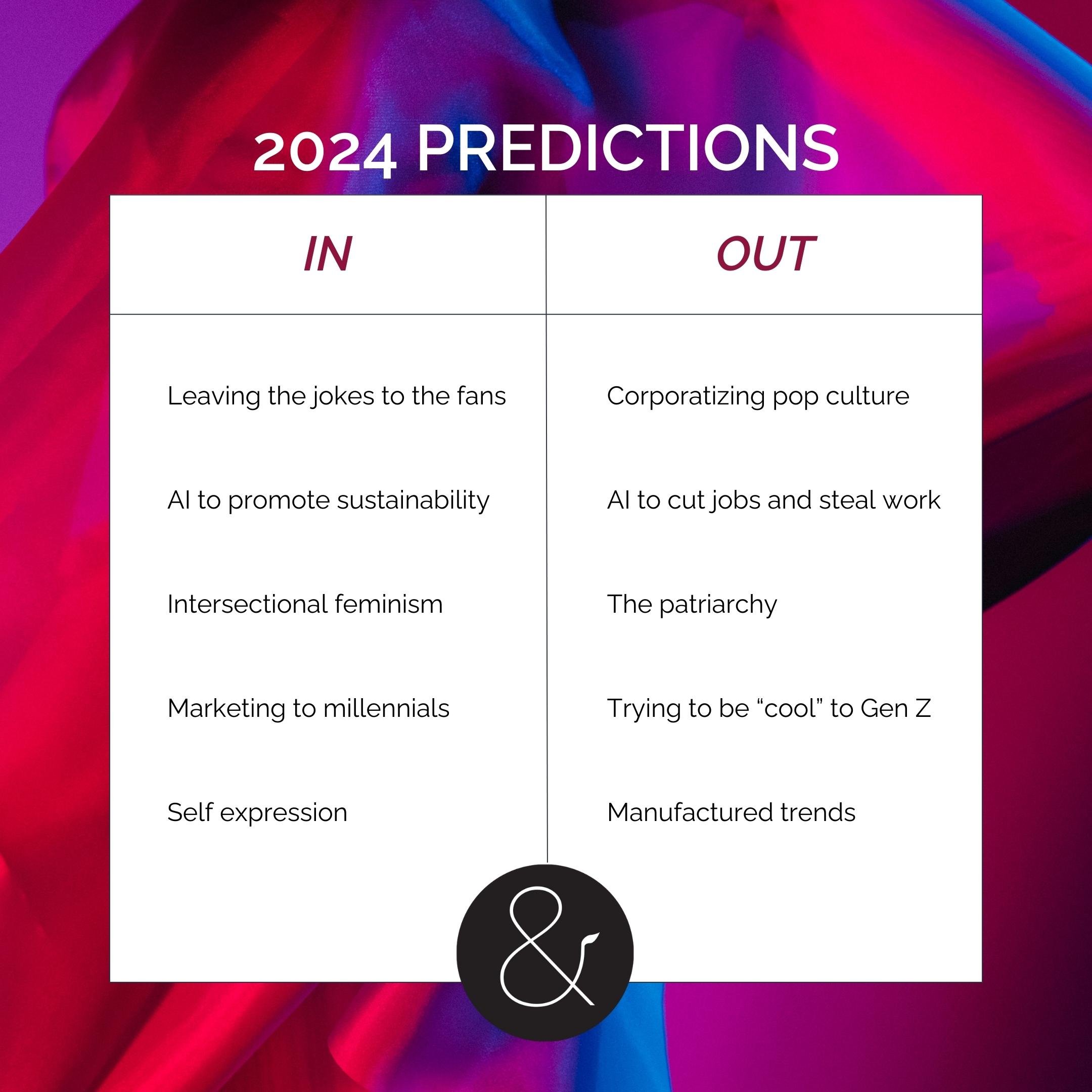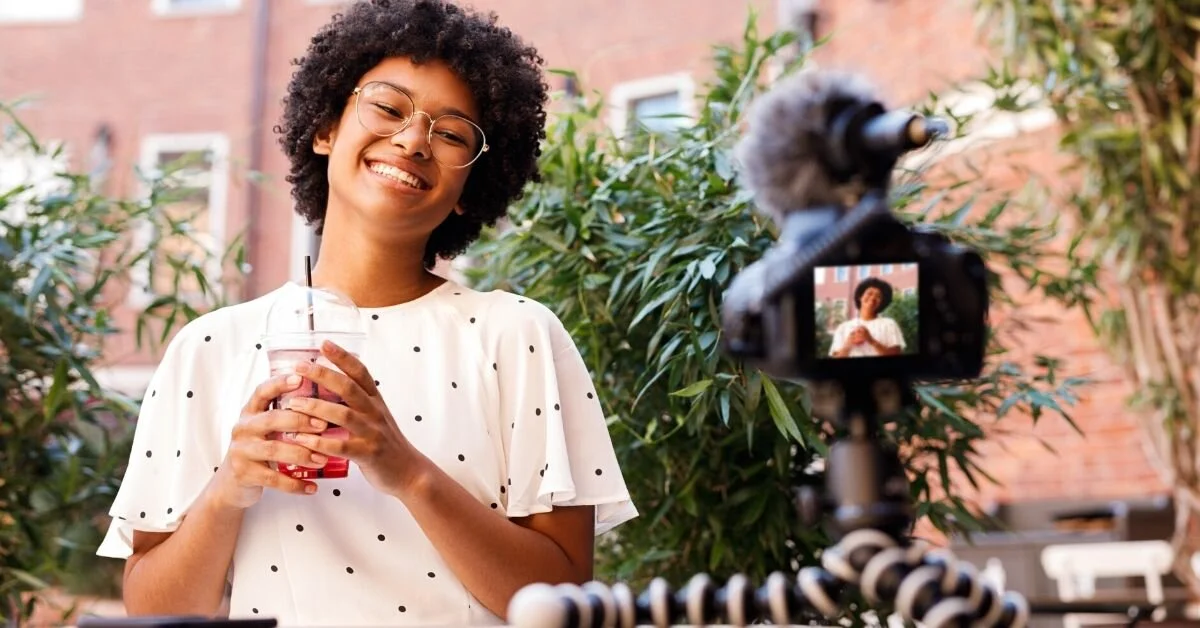5 Trend Shifts to Watch in 2024
16 MIN READ
To know me is to know I love a trend. I will happily spend a few hours getting lost in a new rabbit hole and come out an expert on a completely random subject. It’s a great party trick and surprisingly useful. As a brand strategist, I naturally spend a lot of time thinking about the latest conversations happening on social media and beyond. Given that my trend reports have become a nearly annual tradition (you can read the 2023 and 2021 predictions), I've been keeping my eye on culture shifts and trends I anticipate seeing in the new year.
Before we get into the meat and potatoes of this post, let’s get one trend out of the way: cringe is dead. Instead, we’re embracing all the things that are cringe-y. And I’m telling you this now because I write like the millennial that I am, and even though I pay close attention to Gen Z culture, I have at no point become cool enough to adopt their trends. But I’m hoping this appeals to all the other millennials and any other folks out there who are ready to strategize for 2024.
Brands Taking a Step Back from the Cultural Zeitgeist
We see it happen all the time. A particular moment in pop culture will capture the attention of social media users everywhere. The discussion grows and grows until you can’t be online without seeing a reference to the topic of the moment.
Take “seemingly ranch” for example. Taylor Swift attends one Chiefs game and appears to have a chicken tender with ketchup and “seemingly ranch” according to @tswifterastour. The “seemingly ranch” of it all blew up all over social media—many people feeling like Taylor is just like them for loving a good chicken tender with ranch. The jokes wrote themselves and the global army of Taylor fans were having fun—until the brands got in on the action.
Everyone wanted a piece of “seemingly ranch.” The Empire State Building lit up in white and red in honor of Taylor’s food choice. McDonald’s shifted their branding online to offer “seemingly ranch.” Heinz renamed their Kranch to “Ketchup and Seemingly Ranch.” Each brand’s efforts became more and more gimmicky until they ultimately ruined the joke.
Instead of appreciating the attempts at humor, people began commenting about their dissatisfaction with brands taking things too far. Fans especially felt that Taylor’s relationship with Travis Kelce wasn’t for brands to capitalize on, let alone the niche, inside joke of “seemingly ranch.”
This is just one example of how brands have recently strayed too far away from authentic messaging. In an effort to go viral or be the next Duolingo, they’re losing audience respect and loyalty. As discourse continues around brands “ruining” these pop culture moments for the average person, I predict that we’ll see smart brands being more selective in what cultural trends they get in on. Brands will need to learn the delicate balance of when a viral moment is something for them to comment on, and when they should just leave it to the public.
More Millennial Marketing
Along similar lines, expect to see a shift in brand messaging and the generations it’s tailored toward. Presently, millennials make up the largest share of the US population at 21.67%, meaning people from the ages of 27-42 have the largest buying power in the US. However, scroll through social media or come across any marketing material and you’re likely to see the majority of content geared towards Gen Z. This choice is understandable—Gen Z is the generation of hope. We’re looking to these young adults to shape a better future…and maybe give us better fashion advice.
As a relatively young millennial, I love Gen Z culture. I might not always get it, but I enjoy the way they’re shaping the world around them. If you want to stay up-to-date on youth culture, I highly recommend After School by Casey Lewis. However, there have been many times I’ve physically winced at a brand trying to use Gen Z slang or humor…and falling completely flat. The New York Times recently published an article on the topic, speaking with Gen Z media professionals, and they’ve come to the same conclusion. Brands' attempts to be quirky, cute, or cutting edge are mostly missing the mark because everyone is trying to capture this same voice.
Now is the time to hone in on your brand voice and identity. Instead of trying to sound appealing to Gen Z or like the other brands out there that go “viral,” consider who your audience is. Unless you have a niche product, you’re likely marketing to people across generations, the majority of which are millennials at this point.
This doesn’t mean you have to give up fun, popular terms completely. Instead of trying to get in on every joke, keep your brand values front and center. Look for opportunities to incorporate nostalgia into your messaging, which always seems to be a hit with millennials, or stick to the tried-and-true methods of good storytelling. Long-term success comes from brand trust, which you won’t earn if you seem too preoccupied with garnering attention rather than building a community.
AI, Trend Prediction, and Sustainability
AI is most certainly not going anywhere soon. As AI technology continues to improve, we can anticipate it becoming an essential part of our workdays and the ability to use these tools effectively is vital.
While there is a lot of valid concern surrounding the ethical use of AI, especially when businesses abuse the tools to churn out inferior quality products, there are benefits to using AI that point to a brighter future.
Trend cycles, particularly in fashion, are notoriously hard to predict, and what’s worse, can be extremely detrimental to the environment. To stick with the fashion industry, at each fashion week, trend forecasters will set up shop, furiously taking notes on what common themes they’re seeing on the runways and streets. They’re highly educated guesses, but they’re not data backed and sometimes the trends they predict simply don’t catch on.
Trends that aren’t successful are just a small part of a global crisis. According to the latest research, the fashion industry “is the second-biggest consumer of water and is responsible for about 10% of global carbon emissions—more than all international flights and maritime shipping combined.” It’s hard to wrap your mind around how much of our desire to be on trend can be negatively impacting the environment.
The good news is that AI can help increase sustainability in the fashion industry and others like it. AI models are being developed to predict consumer shopping habits. When paired with the creative minds of trend watchers, these tools can help brands to be more sustainable, hopefully leading to more consistent sales and fewer products in landfills.
Conversations Around Girlhood & Womanhood
A familiar refrain across social media and real life conversations has been the revival of girlhood. The summer of 2023 felt like a celebration of what it feels like to be a young girl: the struggles of growing up and learning your place in the world while also still reveling in your femininity—whatever that means to you. From Taylor Swift’s Eras Tour to the Barbie movie, women were seemingly allowed to delight in things that had been taken from them as they matured. Women even started talking about “girl dinner” and “girl math,” celebrating the unique worldview that we have as women.
However, you’ll notice that all of these trends are through the lens of girlhood, not looking at what it means to be a woman. Many of the trends we saw rise throughout the summer were centered on white feminism or some version of Feminism 101. While understanding feminism is an important starting point for many, it’s not the end journey by any means.
In her Substack, Nikita Walia interviews Melissa Eshaghbeigi to discuss why girlhood has been such a easy concept to sell. Walia shares:
“With all the things happening in policy with Roe v. Wade, just the violence you see out in womanhood doesn't seem that great. It actually seems pretty painful, and I think it's a bitter pill and a big one to swallow.
And so I think girlhood is easy to market and it's easy to sell into little pieces that are fun and sexy and cute and make for a nice Reformation marketing email full of red dresses. And I think it's just easier to sell girlhood because it has potential, whereas womanhood is like, you make the wrong choice of partner and you could actually die.”
I couldn’t agree more with Walia’s take on this. Girlhood is much more appealing because it’s filled with hope and innocence. In girlhood, you don’t have to look at the world and see the harsh realities that could literally destroy your life.
Girlhood is a place of comfort, and I don’t foresee our fascination with this safe space going away anytime soon. However, I hope more conversations will happen like the one between Walia and Eshaghbeigi where we question why girlhood is so attractive, and why as adults we’re not embracing womanhood. As we head into 2024, you can anticipate seeing more discussion on girlhood and hopefully further dialogue on what it means to be a woman in today’s society. The crucial part for brands will be paying attention to what women, particularly women of color, have to say and taking the time to learn how you can best serve their needs and wants.
The Fall of Manufactured Trends
If you spend any time on the beauty side of TikTok, you’ve heard of trends like “latte makeup,” “tomato girl makeup,” and some non-food related ones like “cold girl makeup.” For those not familiar with this part of TikTok, here’s the rundown: every few weeks a beauty trend will pop up out of nowhere. It will be a new look that’s just slightly different from what the community has been doing as a whole. People will rush out to Sephora or the nearest drugstore to get the right products to do the look. And then within a couple of weeks, the trend will become a forgotten memory.
The good news is #BeautyTok is catching on, and “blueberry milk nails'' may have been the nail in the coffin. A close relative of glazed donut nails made popular by Hailey Bieber, blueberry milk nails simply use light blue nail polish. That’s it—no special application process or product. Just light blue nail polish. Yet still many websites and TikTok accounts were calling it the “manicure of the summer.”
While many people were excited to paint their nails light blue, discourse around this trend took on a different tone. People were savvy to the fact these trends are changing so rapidly and how unnecessarily romanticized this nail polish color was—really all in an effort to sell more products for brands. Now we’re seeing more creators talk about “manufactured trends” and why they’re no longer looking to participate in them.
We may like to think this issue is only a problem for beauty brands, but microtrends as a whole are being met with more skepticism. People feel less like members of a community and more like the latest way for brands to make money. Moving forward, it’s essential for brands and content creators alike to be thoughtful in their participation in trend cultivation. Not everything needs to have a unique, romanticized name—instead, lean into the core values of your brand.
To remain in the world of cosmetics, Rare Beauty is one of the most beloved makeup brands across generations at the moment. While they do have the advantage of Selena Gomez as their owner and creator, Rare Beauty also prioritizes their brand values when promoting their products. Products receive names to promote mental health (e.g., Positive Light Silky Touch Highlighter or Warm Wishes Effortless Bronzer Stick). At its core, the brand wants to break down unrealistic beauty standards. Their mission aligns with the values of millennials and Gen Z, and because of this, they don’t have to cater to the manufactured microtrends. At most, their products might be used to create one of the looks, but overall their brand values keep them from falling into this consumerism trap.
Marketing in 2024 is heading toward some heavy changes. Consumers are savvier than ever, and it’s important to be on top of these trends. Have questions about how this could impact your brand? Send me an email at sarah@branchandbramble.com or reach out to us via our contact page.














